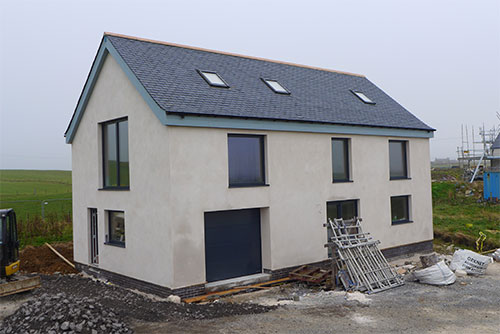Image: UK Hempcrete
It really doesn’t look like much, but hempcrete is the green building material that’s got eco-savvy homeowners and architects excited by its potential to be a sustainable alternative to environmentally expensive bricks and concrete.
It is made using a carefully calibrated mixture of hemp shiv – the dried inner core of the hemp plant – mixed with lime and water.
But although hempcrete seems like a very modern building material, it has a history stretching back over 1,500 years.
Back then, wet hempcrete was cast onsite, as concrete is today, but the challenge of getting the mixture right made it a tricky product for laypeople to use. Too much of any of the three ingredients could make the material runny and weak, while not enough could cause crumbling.
Its drying time also posed problems. In fair conditions, cast hempcrete can take between four and six weeks to cure. But a cold damp winter could slow the process to at least six months, restricting its mass use across northern Europe.
Impeccable environmental credentials
Despite the challenges, hempcrete’s undeniable environmental credentials have meant it was a case of when, rather than if, it would muscle its way into the mainstream building trade.

Image: UKHempcrete
Liam Donohoe, chief operating officer at UK Hempcrete – a Derbyshire-based company designing and supplying materials to building projects using hempcrete – tells Euronews Culture that sustainability plays a part in every area of the product’s development.
“Hemp, unlike conventional crops, doesn’t require a lot of fertilisers or pesticides to protect it as it grows. The type of fibrous hemp usually used in construction is a tall plant that grows quickly and so can be cropped and planted quite close together, naturally suppressing weeds,” he says.
“I’m not saying it takes no energy to produce hempcrete, it does. But when you compare it to man-made insulation and wall infills, it has an unlimited life span and the primary ingredient is a renewable crop that costs a lot less energy and carbon to produce.”
Research and development changed everything
Experiments in France and at Belgium’s University of Leuven in the early 2000s saw researchers begin tackling the barriers preventing hempcrete from realising its full potential as a mainstream building product.
The eureka moment was the development of the hempcrete block or ‘green brick’, which took the specialist skill and guesswork out of using the material.
The lightweight fibrous block opened up a new world of possibilities for the material without diminishing any of its eco-credentials. It is free from volatile organic compounds (VOC) and indefinitely retains its acoustic, moisture absorption and thermal conductivity properties – in sharp contrast to synthetic insulation that decompresses over time to become less effective.
It is now a consistent, lightweight and reliable product that can be easily transported to sites and used by jobbing builders without extensive training.
Hempcrete versus concrete
Despite its versatility, experts are quick to dismiss comparisons between hempcrete and concrete. Concrete is a reinforced, structural building material that can support its own weight, while hempcrete is used around a frame of wood, steel or concrete. Think of it as insulation that doesn’t cost the Earth.
“When hempcrete is made into blocks, it’s strong enough to support itself, so can be used to build multi-storey buildings. There are a number of examples in the Netherlands, South Africa and France, so it’s not that you can’t build high or strong structures with it, but you need to use it around a frame,” Donohoe says.
“Researchers are working on developing a structural application for hempcrete, but that currently means usually tweaking the recipe. The sweet spot is finding something that’s very consistent, that goes onto the building site just like any other building product, without compromising too much on the carbon inputs to the recipe by using ingredients that are less sustainably produced.”
Hempcrete’s time has come
Hempcrete is proving itself to be well-suited to the radically different way many lives are lived in the post-Covid world and the desire to do more to ensure the survival of the planet.
“In the recent past people would commute to their heated offices, do a day’s work and return home to put the heating on for an hour or two in the evening,” Donohoe says.
“We don’t live like that now. Increasingly a lot of us want a nice stable healthy environment at home, because that’s where many live and work.
“Synthetic insulations, such as polyurethane and fibreglass, form a barrier between heat and cold, but they heat-up and cool down very quickly. By contrast, natural materials, such as earth, or hempcrete, are a little slower initially to heat up, but they retain their heat a lot longer – a process called ‘decrement delay’. This process suits today’s world, where people are at home a lot longer, and the heating is on more frequently during the colder months,” he adds.
Europe is setting the pace in hempcrete use

Image: IsoHemp
The major players in the hempcrete world hail from Europe. In the Netherlands, France, Belgium, Germany and Italy, hempcrete is routinely used to retrofit old buildings and form the core of new builds.
One of the biggest producers is Belgian company Isohemp. The Fernelmont-based business has been trading since 2011 and operates in five countries.
It produces more than a million hempcrete blocks a year and claims that the projects it has worked on have saved 18,000 tonnes of C02 from the environment – that’s equivalent to the emissions produced by a patrol car circumnavigating the planet 32,000 times.
Although the UK is a few steps behind the pack, the gap is closing fast. UK Hempcrete knows of 300 to 400 houses in the UK that have been built with hempcrete and sees a bright future for the product.
“The future of hempcrete will be in prefabrication using modular methods of construction. We already have timber-framed houses largely assembled in factories, brought to the site and constructed there. There’s no reason why hempcrete houses can’t be similarly prefabricated,” Donohue says.
“In Britain, companies are building conventional family homes with hempcrete that look just like estate homes anywhere in the country, but with vastly superior eco-performance benefits.
“A focus for us is retrofitting pre-1940s housing stock. We are working with community housing cooperatives around the country who have old houses that are cold and leaky. The biggest opportunity is developing that market alongside the growing newbuild market.”
But perhaps the full potential of hemp and hempcrete has yet to be realised. BMW currently use a weight-saving hemp polymer in the door panels of its i3 electric car, while in southern Italian earthquake zones hempcrete is used as a flexible building material that can cope with Earth movement, rather than rigid, brittle concrete.
The future of hempcrete as a green building material looks assured. But with researchers working on ever more innovative ways to use it, perhaps we’ve only seen a tantalising glimpse of the difference it can make.









 Martyn Holloway, Business Development Manager, Flat Roofing for SFS, comments:
Martyn Holloway, Business Development Manager, Flat Roofing for SFS, comments:
 David Fraser, Business Unit Manager for SFS Subframe Systems, explains, “The NVS-RP features a standard bracket any installer would recognise and know how to fix, and it is now paired with a retaining plate featuring overlapping slots so that it simply slides over the top to retain the insulation and, once you hit the sweet spot, you just put in a rivet to hold it permanently..”
David Fraser, Business Unit Manager for SFS Subframe Systems, explains, “The NVS-RP features a standard bracket any installer would recognise and know how to fix, and it is now paired with a retaining plate featuring overlapping slots so that it simply slides over the top to retain the insulation and, once you hit the sweet spot, you just put in a rivet to hold it permanently..” Cameron MacBride, the National Façade Manager for Kingspan Insulation, confirms: “Kingspan AlphaCore® Pad provides a balance of both thermal and fire performance, giving designers greater freedom to achieve compliant systems in tight spaces. Collaborating with SFS has allowed us to find a solution to maximise the thermal performance of AlphaCore® Pad. The NVS RP range avoids having to fix through the board in multiple places, which reduces thermal bridging. This combination of materials will be used where those pinch-points within a structure occur, in areas where land values are high, and the overall wall thickness becomes more important. These solutions using newer, optimal technologies are therefore going to offer the designer more flexibility in challenging situations, and hopefully boost the lettable or saleable space to its maximum”
Cameron MacBride, the National Façade Manager for Kingspan Insulation, confirms: “Kingspan AlphaCore® Pad provides a balance of both thermal and fire performance, giving designers greater freedom to achieve compliant systems in tight spaces. Collaborating with SFS has allowed us to find a solution to maximise the thermal performance of AlphaCore® Pad. The NVS RP range avoids having to fix through the board in multiple places, which reduces thermal bridging. This combination of materials will be used where those pinch-points within a structure occur, in areas where land values are high, and the overall wall thickness becomes more important. These solutions using newer, optimal technologies are therefore going to offer the designer more flexibility in challenging situations, and hopefully boost the lettable or saleable space to its maximum”
